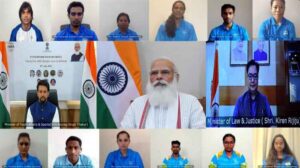It was expected for long. And, on the global cue finally, the government of India has cracked a whip, framing new rules for social media intermediaries, digital media, and OTT platforms, making them accountable for their misuse. The crackdown per sè is not on the various platforms but on the anti-national, anti-social, and criminal elements, who, so far have been spreading lies, propaganda, fake news, hatred, defamatory and obscene content in the absence of stricter norms and accountability. But the onus is on these platforms to ensure ethics, take the offenders to task, set up a redressal mechanism to resolve the complaints and adhere to guidelines laid by the government or face the consequences.
On Thursday, the Information Technology (Intermediary Guidelines and Digital Media Ethics Code) Rules 2021 – under section 87 (2) of the Information Technology Act, 2000 – were announced, not complying to which will essentially remove the ‘safe harbour’ provided by the government to social media platforms like Twitter, Facebook, etc. The guidelines direct over-the-top (OTT) platforms like Netflix, YouTube, etc to launch a three-tier regulation mechanism and self-classify their content into five categories based on the age of the audience.
It took both Ministry of Electronics and Information Technology and Ministry of Information and Broadcasting to get down to elaborate consultations with each other to form an oversight mechanism. While entire guidelines have been notified under the existing Information Technology (IT) Act, the administrative powers for the regulation of OTT and digital news will be under the Ministry of Information and Broadcasting (I&B).
Details of new social media rules
Grievance redressal mechanism:
It seeks to mandate the social media intermediaries to establish a grievance redressal mechanism for receiving and resolving complaints from the users or victims. Intermediaries shall appoint a Grievance Officer to deal with such complaints and share the name and contact details of such officer.
Grievance Officer shall acknowledge the complaint within twenty-four hours and resolve it within fifteen days from its receipt.
Ensure online safety and dignity of users, especially women:
Intermediaries shall remove or disable access within 24 hours of receipt of complaints of contents that expose the private areas of individuals, show such individuals in full or partial nudity or in a sexual act or is in the nature of impersonation including morphed images, etc.
Such a complaint can be filed either by the individual or by any other person on his/her behalf.
Two categories of social media intermediaries:
The rules make a distinction between social media intermediaries and significant social media intermediaries. This distinction is based on the number of users on the social media platform.
The rules require significant social media intermediaries to follow certain additional directives/instructions/precautions with due diligence.
Rules for significant social media intermediaries:
– Appoint a Chief Compliance Officer who shall be responsible for ensuring compliance with the Act and Rules. Such a person should be a resident in India.
– Appoint a Nodal Contact Person for 24×7 coordination with law enforcement agencies. Such a person shall be a resident in India.
– Appoint a Resident Grievance Officer who shall perform the functions mentioned under Grievance Redressal Mechanism. Such a person shall be a resident in India.
– Publish a monthly compliance report mentioning the details of complaints received and action taken on the complaints as well as details of contents removed proactively by the significant social media intermediary.
Identify the first originator of the information for the purposes of prevention, detection, investigation, prosecution or punishment of an offence related to sovereignty and integrity of India, the security of the State, friendly relations with foreign states, or public order or of incitement to an offence relating to the above or in relation with rape, sexually explicit material or child sexual abuse material punishable with imprisonment for a term of not less than five years.
Intermediary shall not be required to disclose the contents of any message or any other information to the first originator.
– Significant social media intermediary shall have a physical contact address in India published on its website or mobile app or both.
Voluntary user verification mechanism:
Users who wish to verify their accounts voluntarily shall be provided an appropriate mechanism to verify their accounts and provided with a demonstrable and visible mark of verification.
Giving users an opportunity to be heard:
In cases where significant social media intermediaries remove or disable access to any information on their own accord, a prior intimation for the same shall be communicated to the user with a notice explaining the grounds and reasons for such action. Users must be provided an adequate and reasonable opportunity to dispute the action taken by the intermediary.
Removal of unlawful information:
An intermediary upon receiving actual knowledge in the form of an order by a court or being notified by the Appropriate Govt, or its agencies through an authorized officer should not host or publish any information which is prohibited under any law in relation to the interest of the sovereignty and integrity of India, public order, friendly relations with foreign countries etc.
While the rules come into effect from the date of their publication in the gazette, the additional due diligence for significant social media intermediaries shall come into effect 3 months after publication of these rules.
Ethics code for digital media and OTT platforms
The rules establish a soft-touch self-regulatory architecture, a Code of Ethics and a three-tier grievance redressal mechanism for news publishers and OTT Platforms and digital media.
Self-Classification of OTT content:
The OTT platforms shall self-classify the content into five age-based categories: U (Universal), U/A 7+, U/A 13+, U/A 16+, and A (Adult).
– Platforms shall implement parental locks for content classified as U/A 13+ or higher, and reliable age verification mechanisms for content classified as “A”.
– The publisher of online curated content shall prominently display the classification rating specific to each content or programme together with a content descriptor informing the user about the nature of the content, and advising on viewer discretion (if applicable) at the beginning of every programme enabling the user to make an informed decision, prior to watching the programme.
Conduct code for digital media:
Publishers of news on digital media would be required to observe Norms of Journalistic Conduct of the Press Council of India and the Programme Code under the Cable Television Networks Regulation Act thereby providing a level playing field between the offline (Print, TV) and digital media.
Three-level grievance redressal mechanism:
– Level-I: Self-regulation by the publishers
– Level-II: Self-regulation by the self-regulating bodies of the publishers
– Level-III: Oversight mechanism
Also Read: Beware of illegal digital lending apps, warns RBI
Self-regulation by the Publisher:
Publisher shall appoint a Grievance Redressal Officer based in India who shall be responsible for the redressal of grievances received by it. The officer shall take decision on every grievance received by it within 15 days.
Self-Regulatory Body:
There may be one or more self-regulatory bodies of publishers. Such a body shall be headed by a retired judge of the Supreme Court, a High Court or independent eminent person and have not more than six members. Such a body will have to register with the Ministry of Information and Broadcasting. This body will oversee the adherence by the publisher to the Code of Ethics and address grievances that have not be been resolved by the publisher within 15 days.
Oversight Mechanism:
Ministry of Information and Broadcasting shall formulate an oversight mechanism. It shall publish a charter for self-regulating bodies, including Codes of Practices. It shall establish an Inter-Departmental Committee for hearing grievances.









50 jobs at risk of being replaced by ChatGPT
Just show your face and board the flight
New Maruti Baleno 2022: Features, specifications and more